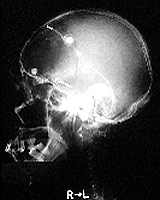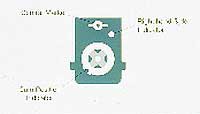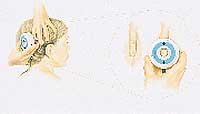Device allows adjustments for lumboperitoneal shunting
The device is programmed magnetically to control pressure after implantation.
MONT TREMBLANT, Quebec — An externally adjustable valve can deliver programmable shunting for pseudotumor cerebri patients, said Valerie A. Purvin, MD.
“One of the limiting factors with the idea of shunts for pseudotumor is that they don’t last forever,” she said.
Most patients are treated for high pressure, and many times the shunt causes a persistently low cerebral spinal fluid (CSF) pressure. The only way to fix that is to exchange shunts and begin the treatment course again.
The Codman Hakim programmable valve (Codman; Raynham, Mass.) can be used for hydrocephalus, normal pressure hydrocephalus, arachnoid cysts and also pseudotumor cerebri syndrome. European surgeons have used the device for several years, and the U.S. Food and Drug Administration has recently approved the device.
 ---X-ray shows the notch of the Codman Hakim programmable valve indicating the valve’s setting.
---X-ray shows the notch of the Codman Hakim programmable valve indicating the valve’s setting.
The device uses a valve inside the shunt. A synthetic ruby sits on top of the opening for the valve that can be dialed with a magnet. A spring coil adjusts the pressure.
X-rays will show the notch that shows the valve’s setting. Patients can undergo magnetic resonance imaging tests, but will require re-adjustment of the valve after the procedure, Dr. Purvin said.
The European literature reported a subgroup of 16 pseudotumor patients treated as part of a larger group that received the shunt. In the pseudotumor patients, 31% required reprogramming after their first valve placement. The outcome was excellent in 64% of patients and good in 28%.
The shunt costs significantly more than other procedures, Dr. Purvin said. However, a patient may undergo dozens of shunt revisions over a lifetime, so one implantation with a programmable valve may be more cost effective.
LPS shunting
Lumboperitoneal shunting (LPS) is effective for treating symptoms and visual loss associated with pseudotumor cerebri syndrome, she said. The incidence of serious complications is low. The main drawback is the need for multiple shunt revisions in a subgroup of patients that cannot be identified preoperatively.
Proposed indications for LPS include:
- intractable symptoms despite maximal medical management, with or without papilledema or visual loss;
- severe visual loss;
- progressive visual loss despite optic nerve sheath fenestration and maximal medications; and
- as an adjunct to gastroplasty.
The shunt may work well with gastroplasty, she said. Weight loss will decrease the CSF pressure, and the shunt will eventually become unnecessary.
Other technological advances may change indications for shunting and how it works. Stereotactic computerized tomography (CT) allows for improved implantation of catheters into a small ventricle.
“Neurosurgeons who do a lot of this are generally comfortable that they can do it without CT guidance. But I’m not saying that you need that in order to use a shunt for pseudotumor,” she said.
Predicting efficacy
Dr. Purvin also addressed how effective shunting is, how long the procedure controls symptoms and what are the risks and complications.
“When we talk about relief of symptoms, we’re primarily talking about headache, although you understand that, in some people, diplopia is going to be intractable, or pulsatile tinnitus will be enough of a problem that those symptoms will require treatment in and of themselves with or without headache,” she said.
Dr. Purvin reviewed charts of 168 patients with pseudotumor cerebri between 1983 and 1995. They found 30 patients who had undergone LPS.
The study group had a mean age of 32.9 years old with a range of 10 years to 68 years. Most (28) were female. Etiologies included obesity in 23, idiopathic in three, chronic obstructive pulmonary disease in two, steroid withdrawal in one and menarche in one.
Of this group, 17 underwent full neuro-ophthalmic evaluation. There was significant improvement in 82% of patients. One had a persistent high-pressure headache and another suffered from low-pressure syndrome.
Dr. Purvin looked at visual acuity, visual field and papilledema. Twenty eyes had 20/25 vision or better and were stable postoperatively. Of the remaining 14 eyes that had 20/30 vision or worse, 10 improved. The remaining four improved by seven lines or more. One eye of those four returned from no light perception to 20/25.
In examining visual field defects in 26 eyes with an abnormal preoperative visual field, five (19%) normalized, 13 (50%) significantly improved and eight (30%) were unchanged. No eyes were worse postoperatively.
In looking at papilledema, 24 of 25 eyes with severe papilledema preoperatively showed complete or near complete resolution. After surgery, seven eyes with mild or moderate edema showed complete resolution.
LPS shunting works immediately and reliably on symptoms and optic nerve function, Dr. Purvin said.
The average shunt duration is 12 months, and the average revision rate is 2.9 per patient. However, shunt revisions are not uniformly distributed among the patients in the shunted group. Some patients do very well with just one shunt, but a subgroup needed multiple shunts.
“Before you even embark on the first shunt, it would be nice to know who’s not likely to do well and, therefore, for whom you should do something else,” she said. “That’s been a problem and we really don’t have the answer for that.”
|
|
|
For Your Information:
- Valerie A. Purvin, MD, can be reached at the Midwest Eye Institute, 201 Pennsylvania Parkway, Indianapolis, IN 46280-1381; (317) 817-1827; fax: (317) 817-1027. Dr. Purvin has no direct financial interest in any of the products mentioned in this article, nor is she a paid consultant for any companies mentioned.
- Codman, a Johnson & Johnson Company, can be reached at 325 Paramount Drive, Raynham, MA 02767; (800) 225-0460; fax: (508) 828-3056.


